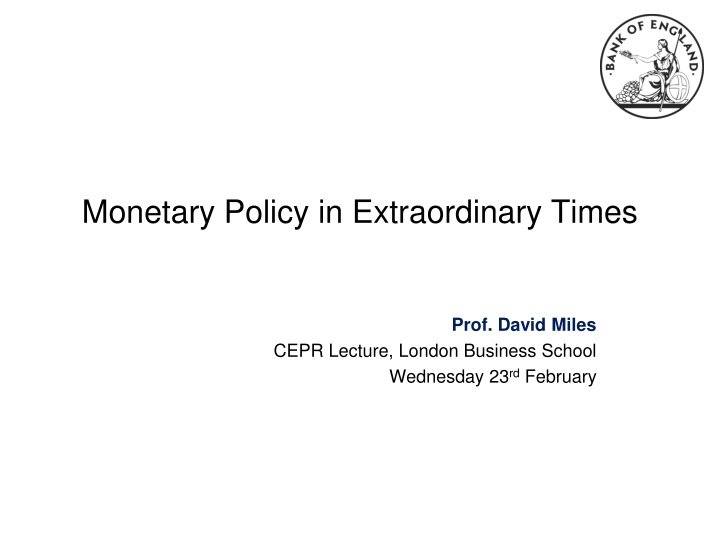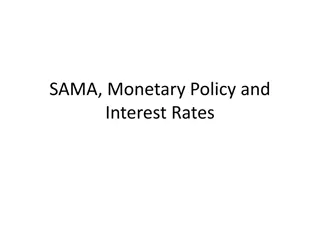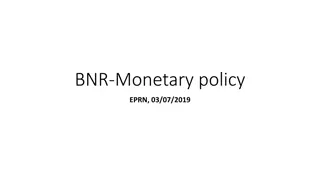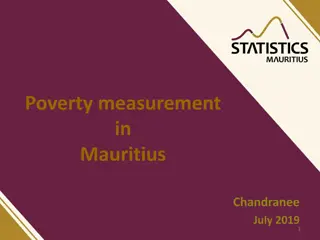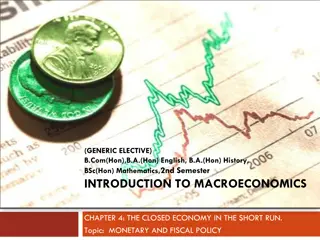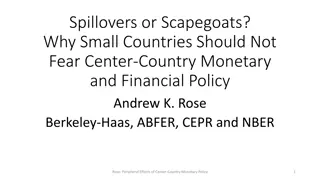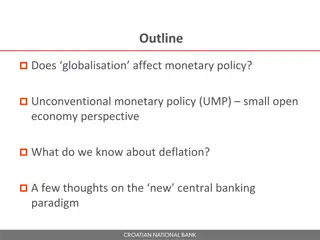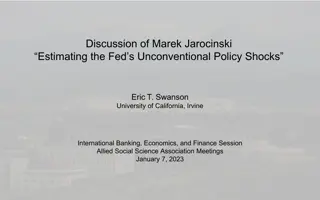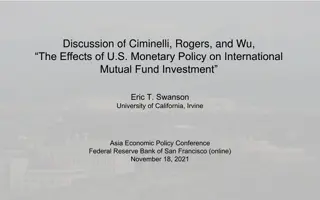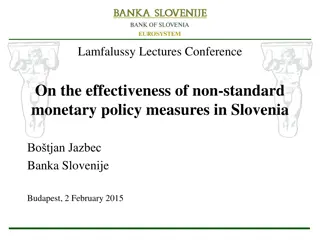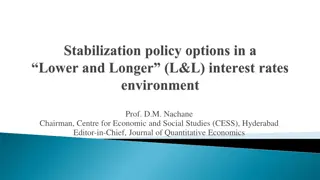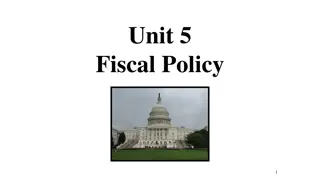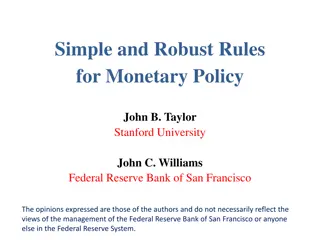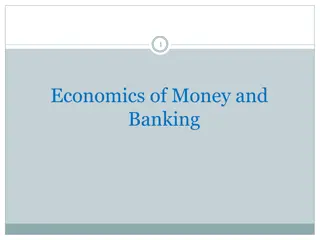Monetary Policy in Extraordinary Times
Data on monetary policy, output levels during recessions, commodity prices, public sector debt, inflation rates, GDP projections, and bank rates. Gain insights into economic trends and policy decisions from various charts and graphs presented in the content.
Uploaded on Feb 18, 2025 | 2 Views
Download Presentation

Please find below an Image/Link to download the presentation.
The content on the website is provided AS IS for your information and personal use only. It may not be sold, licensed, or shared on other websites without obtaining consent from the author.If you encounter any issues during the download, it is possible that the publisher has removed the file from their server.
You are allowed to download the files provided on this website for personal or commercial use, subject to the condition that they are used lawfully. All files are the property of their respective owners.
The content on the website is provided AS IS for your information and personal use only. It may not be sold, licensed, or shared on other websites without obtaining consent from the author.
E N D
Presentation Transcript
Monetary Policy in Extraordinary Times Prof. David Miles CEPR Lecture, London Business School Wednesday 23rdFebruary
Level of Output Relative to Pre-Crisis Trend During Past Recessions (a) Yearsfrom start of the recession 100 Index based in year of peak level of output 1 2 3 4 5 6 7 98 96 94 2008 1990 92 1979 1929 90 1973 88 (a) I use GDP and trend growth estimates from Hills, Thomas and Dimsdale ( Bank of England Quarterly Bulletin 2010) to create this chart. The authors use a Hodrick-Prescott filter to separate the trend and the cyclical components of real GDP growth. I assume that their trend growth estimate at the start of each recession would have prevailed during the following seven years had the recession not occurred. The chart shows deviations of actual GDP from this projected trend growth. The dotted line for the latest recession uses the MPC s mean projection for output growth over the forecast horizon as reported in the February 2011 Inflation report. 2
Commodity Prices (in , Jan 2007 = 100) 300 Agriculture and livestock 250 Industrial Metals 200 150 Oil 100 Total Commodities 50 0 Jan/07 Jan/08 Jan/09 Jan/10 Jan/11 3 Note: The total commodities series uses the GSCI index.
Public Sector Stock of Net Debt (% of GDP) 300 250 200 150 100 50 0 1855 1875 1895 1915 1935 1955 1975 1995 Note: The ONS calculate public sector net debt as financial liabilities less liquid assets and does not include all assets and liabilities of the public sector. The public sector, including the banks classified to the public sector, owns considerable amounts of illiquid assets, but these are not taken into account in the calculation of net debt. Source: 1855-2007 Hills, Thomas and Dimsdale (Bank of England Quarterly Bulletin 2010), 2007-2009 ONS series code RUTO . 4
Annual Inflation 30 % CPI RPI 25 20 15 10 5 0 -5 1963 1973 1983 1993 2003 Source: ONS 5
Projected Level of GDP Note: The width of this fan chart over the past is to take account of likely revisions of the data. Source: Bank of England Inflation Report, February 2011 6
Bank Rate Since 1964 % 18 16 14 12 10 8 6 4 2 0 1700 2000 1800 1900 Source: Bank of England 7
CPI Inflation and the Contribution of VAT, Energy Prices and Import Prices Note: The blue swathe sums the minimum and maximum of the individual estimated impacts of VAT, energy prices and import prices on CPI inflation. Source: Bank of England Inflation Report, February 2011 8
Interest Rates Faced by Households and Firms Bank Rate Household unsecured borrowing rate Household deposit rate Household secured borrowing rate Corporate borrowing rate (bond yields) Per cent 20 15 10 5 0 00 01 02 03 04 05 06 07 08 09 10 11 Note: -the corporate borrowing rate series uses an index of BBB-rated sterling corporate bonds issued by non-financial companies with a current average maturity of 8.5 years. - the household lending and deposit rate series show data on quoted rates by UK Monetary and Financial Institutions. Source: Bank of England and Bank of America Merrill Lynch 9
Quarter-on-quarter Inflation Rates Percentage change on a quarterearlier 3 2 1 0 2005 2006 2007 2008 2009 2010 2011 2012 2013 2014 Note: Seasonally adjusted. Projections from 2011 onwards are for the mode. 10
UK Debt by Sector as % of GDP 500 % Corporate 450 Household 400 Financial 350 300 250 200 150 100 50 0 1987 1990 1993 1996 1999 2002 2005 11
Monetary and Financial Institutions Assets % of nominal GDP 1200 1000 800 600 400 200 0 1987 1990 1993 1996 1999 2002 2005 2008 12
Leverage of UK Major Banks Ratio Max-min range Median 90 80 70 60 50 40 30 20 10 0 2005 2006 2007 2008 H1 2009 2009 H1 2010 Source: Banks published financial accounts. 13
UK Banks Leverage Ratio (a) 40 (b) (c) 35 30 25 20 15 10 5 0 1880 1900 1920 1940 1960 1980 2000 (a) UK data on leverage use total assets over equity and reserves on a time-varying sample of banks, representing the majority of the UK banking system, in terms of assets. Prior to 1970 published accounts understated the true level of banks' capital because they did not include hidden reserves. The solid line adjusts for this. 2009 observation is from H1. (b) Change in UK accounting standards. (c) International Financial Reporting Standards (IFRS) were adopted for the end-2005 accounts. The end-2004 accounts were also restated on an IFRS basis. The switch from UK GAAP to IFRS reduced the capital ratio of the UK banks in the sample by approximately 1 percentage point in 2004. 14
UK Banks Liquidity Ratio (a) (a) From 1968 the liquidity ratio is: Cash + Bank of England balances + money at call + eligible bills + UK gilts as a percentage of banks' total asset holdings. Pre-1968 the ratio is calculated as the liquid assets of the London Clearing Banks as a percentage of gross deposits. 15
Economic Impact of Reducing Leverage from 30 to 15 (Doubling Tier 1 Capital from 8.4% to 16.8% of risk-weighted assets) Basis Points Tax effect, no M-M Tax effect, 45% M-M Base case: no tax No tax effect effect, 45% M-M and 75% M-M Change in banks WACC 38.0 22.5 17.9 7.7 Change in PNFC WACC 12.7 7.5 6.0 2.6 Fall in long run GDP 31.7 18.8 14.9 6.4 Present value of GDP lost 1268 751 596 256 Source: Miles, Yang, Marcheggiano (2011) 16
